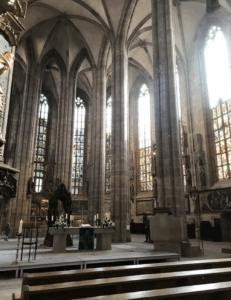BY: GRACIE COLLIER

A photo I took at St. Sebaldus Church, Nuremberg, Germany
My career path in life has been winding, to say the least. Unlike in European countries, where youths are expected to start selecting their path and specializations even before graduation, in the US, we seem to encourage more disparate experiences, seeing where life takes you. There has always been a core interest, a core pursuit, in my life. It is through the Museum Studies program that I have started to settle on a career-based approach to my interests.
As an emerging museum professional, I am ripe with passion, especially for the museums that serve as spaces for multilayered experiences of reality, often as spiritual dimensions. I am still struggling to come up with a catch-all name to express this interest. But I can articulate well what I want to do, fortunately. I am interested in the development and care of spaces that provide experiences that transcend the everyday experience of life. In traditional Religious Studies texts, like Mircea Eliade’s The Sacred and the Profane (1957), these spaces are called “sacred spaces.” However, I believe that they can exist beyond the altar, are places that can happen while hiking up a mountain, at sites of remembrance, or even in the still and calm of an abandoned building. I want to be a caretaker for such settings, as they contribute much to a person’s well-being.
But why museums then? At first, I tried to be the creator of these sites, of what goes into them, as an artist. But without proper financing, such an endeavor would not pan out long-term as a sustainable option. Then perhaps through ordination. But that also failed to pan out, meeting surprisingly high levels of resistance to my joining the clergy. So, as an artist, undergraduate who specialized in Art History and Religious Studies, who has done work as a lay person in traditional, religious sacred spaces, how about through museums? After all, some temples and churches function both as houses of worship and as museums. And even the most secular of museums are places for experiencing different elements of our world, the most common being through education. After all, secular does not have to mean sans spirituality; it can mean choosing not to identify with any set religion, keeping equidistance from each one, and valuing each equally and equitably. Through museums, I could engage with a greater diversity of spaces, not limited to my religion or religion at all.
But why do I want to be a caretaker of these sites? Why would it not be enough to simply engage with them through academic research? Because I believe there is something to these physical places, to the physicality of the experience, that allows for greater learning and greater exposure to other aspects of what is being studied. Not every person entering a museum will have that hard-to-define moment, but many will, and I want to facilitate and encourage such moments, because I know firsthand just how special such experiences are.
You see, I am addicted to these spaces and the moments they provide. I cannot help but talk about them as one might an epiphany, from traditional settings like a beautiful stained-glassed church interior, a more modern, solemn remembrance at a Holocaust camp, to a room in an art gallery, the sun softly descending through the window. In the hustle and bustle of our late-stage capitalist world, humans do not often sit down and take in the world, feel our lives through all our senses, and in ways that connect to different parts of our brains. I want to bring and share these moments with others.
My portfolio is a showcase of my work for job applications, yes, but it is also an overview of my story, of what has built up my passion, of what has cultivated this love within me that, in turn, I can use to cultivate what I love. In the creation of my portfolio, a summation of my work up until now, these spaces have remained a focal point of my work. My portfolio is a glimpse into the work I have done for this pursuit; I hope it might inspire you as well. And, if you happen to have any questions or want to know more, reach out, for I am always happy to discuss.
Full Portfolio Link: https://mgctori.wixsite.com/graciecollier
Gracie Collier received her MA in Museum Studies from IU Indianapolis in May 2025.

